Year 1 Math & Science: Pattern Unit Planner for Diverse Learners
VerifiedAdded on 2023/01/23
|9
|3602
|63
Homework Assignment
AI Summary
This assignment presents a comprehensive unit planner for Year 1 mathematics and science, focusing on the concept of patterns and algebra for a class of 20 diverse students in North Adelaide. The planner outlines the learning focus, which includes understanding repeating and growing patterns, as well as developing algebraic thinking. It details the processes of questioning, problem-solving, and communication. The assignment incorporates five sequential learning experiences based on the 5Es model, encompassing engagement, exploration, explanation, elaboration, and evaluation. These experiences involve activities such as identifying patterns, writing number patterns, and group discussions. The planner also addresses differentiation strategies to cater to diverse learners, including visual aids and personalized attention. Furthermore, it outlines assessment methods to evaluate student understanding of algebraic concepts, mathematical functions, and proportional reasoning. The unit extends over a couple of weeks with home assignments, group discussions and self-reflection, to reinforce the concepts and enable deeper understanding.
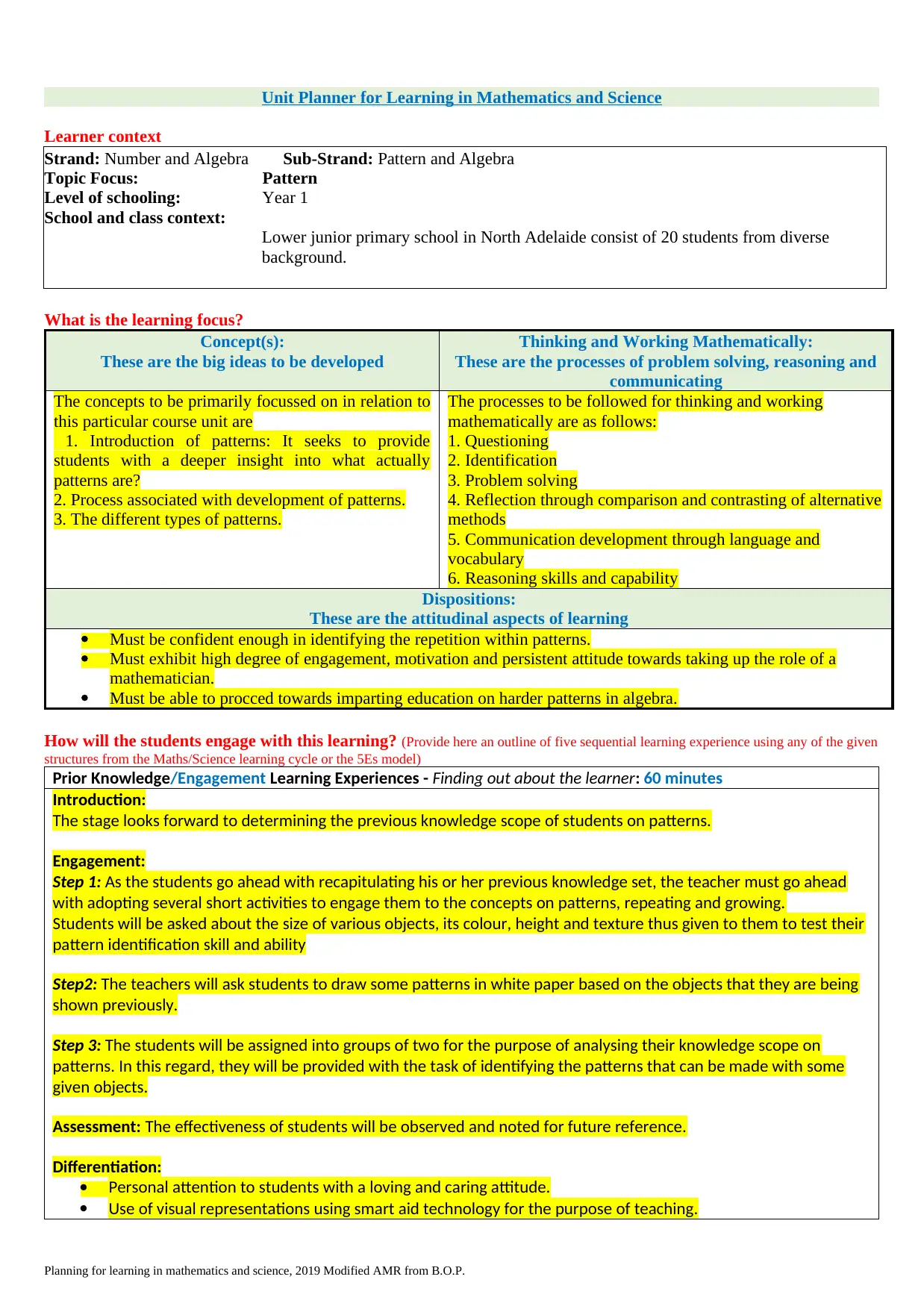
Unit Planner for Learning in Mathematics and Science
Learner context
Strand: Number and Algebra Sub-Strand: Pattern and Algebra
Topic Focus: Pattern
Level of schooling: Year 1
School and class context:
Lower junior primary school in North Adelaide consist of 20 students from diverse
background.
What is the learning focus?
Concept(s):
These are the big ideas to be developed
Thinking and Working Mathematically:
These are the processes of problem solving, reasoning and
communicating
The concepts to be primarily focussed on in relation to
this particular course unit are
1. Introduction of patterns: It seeks to provide
students with a deeper insight into what actually
patterns are?
2. Process associated with development of patterns.
3. The different types of patterns.
The processes to be followed for thinking and working
mathematically are as follows:
1. Questioning
2. Identification
3. Problem solving
4. Reflection through comparison and contrasting of alternative
methods
5. Communication development through language and
vocabulary
6. Reasoning skills and capability
Dispositions:
These are the attitudinal aspects of learning
Must be confident enough in identifying the repetition within patterns.
Must exhibit high degree of engagement, motivation and persistent attitude towards taking up the role of a
mathematician.
Must be able to procced towards imparting education on harder patterns in algebra.
How will the students engage with this learning? (Provide here an outline of five sequential learning experience using any of the given
structures from the Maths/Science learning cycle or the 5Es model)
Prior Knowledge/Engagement Learning Experiences - Finding out about the learner: 60 minutes
Introduction:
The stage looks forward to determining the previous knowledge scope of students on patterns.
Engagement:
Step 1: As the students go ahead with recapitulating his or her previous knowledge set, the teacher must go ahead
with adopting several short activities to engage them to the concepts on patterns, repeating and growing.
Students will be asked about the size of various objects, its colour, height and texture thus given to them to test their
pattern identification skill and ability
Step2: The teachers will ask students to draw some patterns in white paper based on the objects that they are being
shown previously.
Step 3: The students will be assigned into groups of two for the purpose of analysing their knowledge scope on
patterns. In this regard, they will be provided with the task of identifying the patterns that can be made with some
given objects.
Assessment: The effectiveness of students will be observed and noted for future reference.
Differentiation:
Personal attention to students with a loving and caring attitude.
Use of visual representations using smart aid technology for the purpose of teaching.
Planning for learning in mathematics and science, 2019 Modified AMR from B.O.P.
Learner context
Strand: Number and Algebra Sub-Strand: Pattern and Algebra
Topic Focus: Pattern
Level of schooling: Year 1
School and class context:
Lower junior primary school in North Adelaide consist of 20 students from diverse
background.
What is the learning focus?
Concept(s):
These are the big ideas to be developed
Thinking and Working Mathematically:
These are the processes of problem solving, reasoning and
communicating
The concepts to be primarily focussed on in relation to
this particular course unit are
1. Introduction of patterns: It seeks to provide
students with a deeper insight into what actually
patterns are?
2. Process associated with development of patterns.
3. The different types of patterns.
The processes to be followed for thinking and working
mathematically are as follows:
1. Questioning
2. Identification
3. Problem solving
4. Reflection through comparison and contrasting of alternative
methods
5. Communication development through language and
vocabulary
6. Reasoning skills and capability
Dispositions:
These are the attitudinal aspects of learning
Must be confident enough in identifying the repetition within patterns.
Must exhibit high degree of engagement, motivation and persistent attitude towards taking up the role of a
mathematician.
Must be able to procced towards imparting education on harder patterns in algebra.
How will the students engage with this learning? (Provide here an outline of five sequential learning experience using any of the given
structures from the Maths/Science learning cycle or the 5Es model)
Prior Knowledge/Engagement Learning Experiences - Finding out about the learner: 60 minutes
Introduction:
The stage looks forward to determining the previous knowledge scope of students on patterns.
Engagement:
Step 1: As the students go ahead with recapitulating his or her previous knowledge set, the teacher must go ahead
with adopting several short activities to engage them to the concepts on patterns, repeating and growing.
Students will be asked about the size of various objects, its colour, height and texture thus given to them to test their
pattern identification skill and ability
Step2: The teachers will ask students to draw some patterns in white paper based on the objects that they are being
shown previously.
Step 3: The students will be assigned into groups of two for the purpose of analysing their knowledge scope on
patterns. In this regard, they will be provided with the task of identifying the patterns that can be made with some
given objects.
Assessment: The effectiveness of students will be observed and noted for future reference.
Differentiation:
Personal attention to students with a loving and caring attitude.
Use of visual representations using smart aid technology for the purpose of teaching.
Planning for learning in mathematics and science, 2019 Modified AMR from B.O.P.
Paraphrase This Document
Need a fresh take? Get an instant paraphrase of this document with our AI Paraphraser
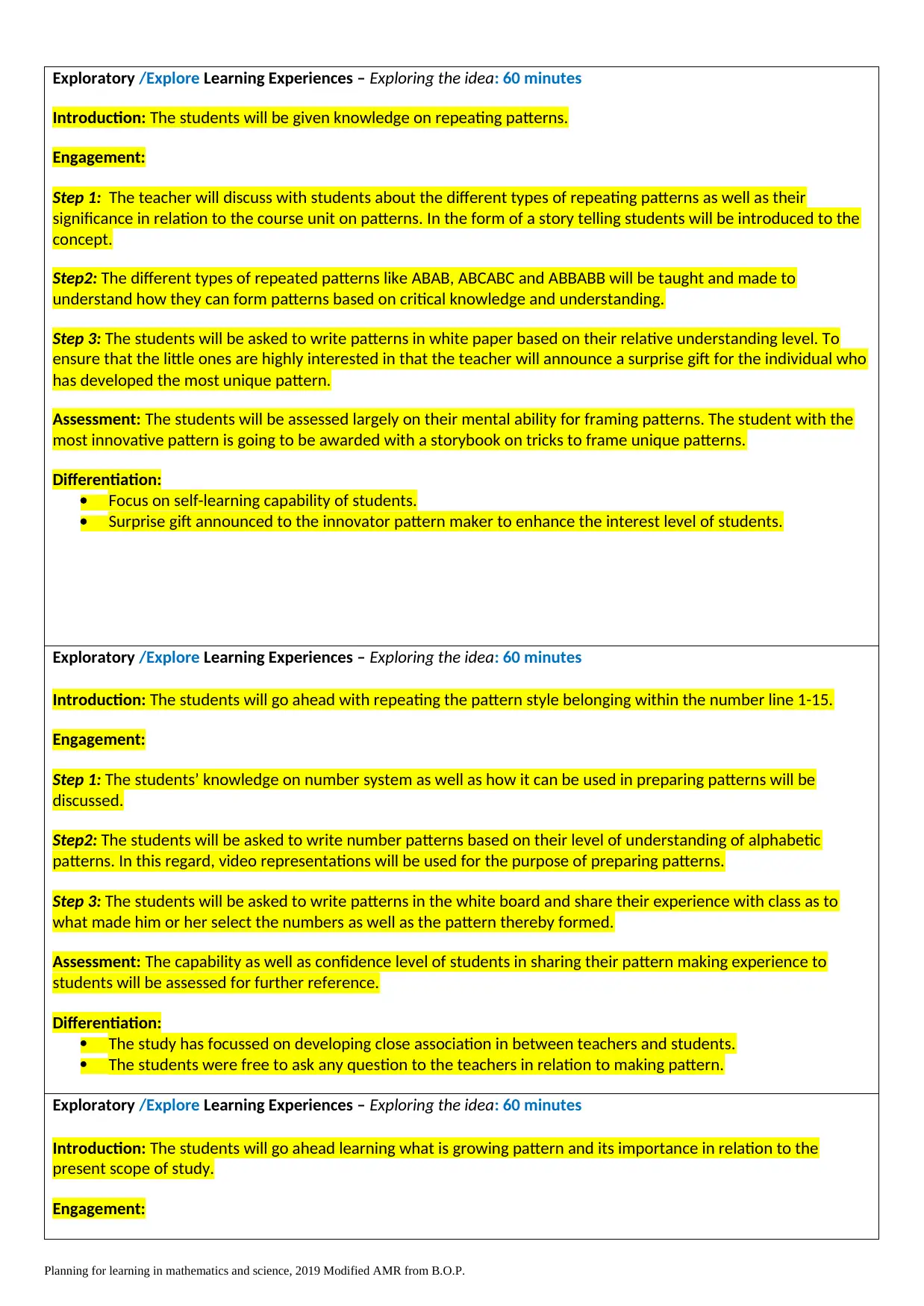
Exploratory /Explore Learning Experiences – Exploring the idea: 60 minutes
Introduction: The students will be given knowledge on repeating patterns.
Engagement:
Step 1: The teacher will discuss with students about the different types of repeating patterns as well as their
significance in relation to the course unit on patterns. In the form of a story telling students will be introduced to the
concept.
Step2: The different types of repeated patterns like ABAB, ABCABC and ABBABB will be taught and made to
understand how they can form patterns based on critical knowledge and understanding.
Step 3: The students will be asked to write patterns in white paper based on their relative understanding level. To
ensure that the little ones are highly interested in that the teacher will announce a surprise gift for the individual who
has developed the most unique pattern.
Assessment: The students will be assessed largely on their mental ability for framing patterns. The student with the
most innovative pattern is going to be awarded with a storybook on tricks to frame unique patterns.
Differentiation:
Focus on self-learning capability of students.
Surprise gift announced to the innovator pattern maker to enhance the interest level of students.
Exploratory /Explore Learning Experiences – Exploring the idea: 60 minutes
Introduction: The students will go ahead with repeating the pattern style belonging within the number line 1-15.
Engagement:
Step 1: The students’ knowledge on number system as well as how it can be used in preparing patterns will be
discussed.
Step2: The students will be asked to write number patterns based on their level of understanding of alphabetic
patterns. In this regard, video representations will be used for the purpose of preparing patterns.
Step 3: The students will be asked to write patterns in the white board and share their experience with class as to
what made him or her select the numbers as well as the pattern thereby formed.
Assessment: The capability as well as confidence level of students in sharing their pattern making experience to
students will be assessed for further reference.
Differentiation:
The study has focussed on developing close association in between teachers and students.
The students were free to ask any question to the teachers in relation to making pattern.
Exploratory /Explore Learning Experiences – Exploring the idea: 60 minutes
Introduction: The students will go ahead learning what is growing pattern and its importance in relation to the
present scope of study.
Engagement:
Planning for learning in mathematics and science, 2019 Modified AMR from B.O.P.
Introduction: The students will be given knowledge on repeating patterns.
Engagement:
Step 1: The teacher will discuss with students about the different types of repeating patterns as well as their
significance in relation to the course unit on patterns. In the form of a story telling students will be introduced to the
concept.
Step2: The different types of repeated patterns like ABAB, ABCABC and ABBABB will be taught and made to
understand how they can form patterns based on critical knowledge and understanding.
Step 3: The students will be asked to write patterns in white paper based on their relative understanding level. To
ensure that the little ones are highly interested in that the teacher will announce a surprise gift for the individual who
has developed the most unique pattern.
Assessment: The students will be assessed largely on their mental ability for framing patterns. The student with the
most innovative pattern is going to be awarded with a storybook on tricks to frame unique patterns.
Differentiation:
Focus on self-learning capability of students.
Surprise gift announced to the innovator pattern maker to enhance the interest level of students.
Exploratory /Explore Learning Experiences – Exploring the idea: 60 minutes
Introduction: The students will go ahead with repeating the pattern style belonging within the number line 1-15.
Engagement:
Step 1: The students’ knowledge on number system as well as how it can be used in preparing patterns will be
discussed.
Step2: The students will be asked to write number patterns based on their level of understanding of alphabetic
patterns. In this regard, video representations will be used for the purpose of preparing patterns.
Step 3: The students will be asked to write patterns in the white board and share their experience with class as to
what made him or her select the numbers as well as the pattern thereby formed.
Assessment: The capability as well as confidence level of students in sharing their pattern making experience to
students will be assessed for further reference.
Differentiation:
The study has focussed on developing close association in between teachers and students.
The students were free to ask any question to the teachers in relation to making pattern.
Exploratory /Explore Learning Experiences – Exploring the idea: 60 minutes
Introduction: The students will go ahead learning what is growing pattern and its importance in relation to the
present scope of study.
Engagement:
Planning for learning in mathematics and science, 2019 Modified AMR from B.O.P.
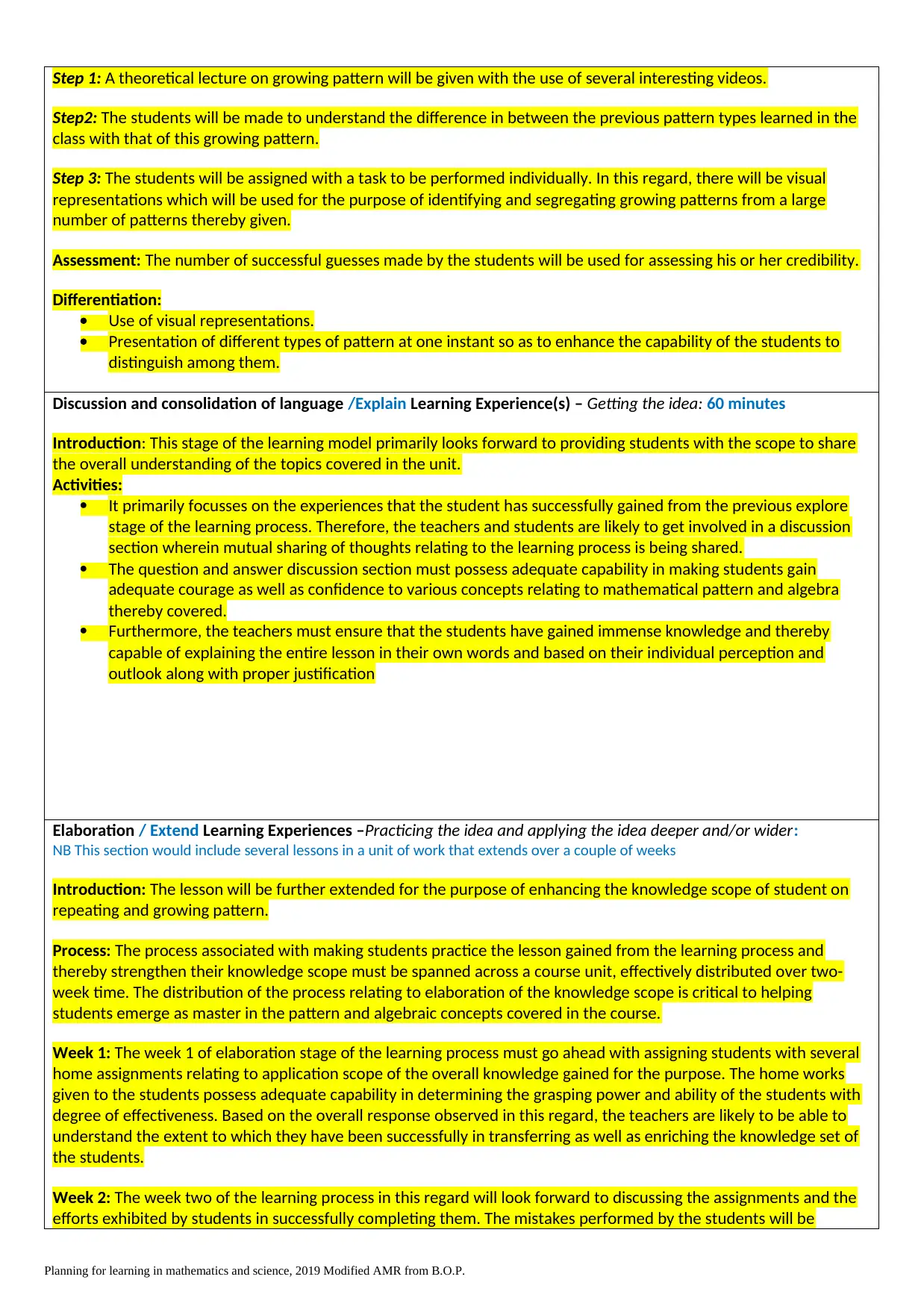
Step 1: A theoretical lecture on growing pattern will be given with the use of several interesting videos.
Step2: The students will be made to understand the difference in between the previous pattern types learned in the
class with that of this growing pattern.
Step 3: The students will be assigned with a task to be performed individually. In this regard, there will be visual
representations which will be used for the purpose of identifying and segregating growing patterns from a large
number of patterns thereby given.
Assessment: The number of successful guesses made by the students will be used for assessing his or her credibility.
Differentiation:
Use of visual representations.
Presentation of different types of pattern at one instant so as to enhance the capability of the students to
distinguish among them.
Discussion and consolidation of language /Explain Learning Experience(s) – Getting the idea: 60 minutes
Introduction: This stage of the learning model primarily looks forward to providing students with the scope to share
the overall understanding of the topics covered in the unit.
Activities:
It primarily focusses on the experiences that the student has successfully gained from the previous explore
stage of the learning process. Therefore, the teachers and students are likely to get involved in a discussion
section wherein mutual sharing of thoughts relating to the learning process is being shared.
The question and answer discussion section must possess adequate capability in making students gain
adequate courage as well as confidence to various concepts relating to mathematical pattern and algebra
thereby covered.
Furthermore, the teachers must ensure that the students have gained immense knowledge and thereby
capable of explaining the entire lesson in their own words and based on their individual perception and
outlook along with proper justification
Elaboration / Extend Learning Experiences –Practicing the idea and applying the idea deeper and/or wider:
NB This section would include several lessons in a unit of work that extends over a couple of weeks
Introduction: The lesson will be further extended for the purpose of enhancing the knowledge scope of student on
repeating and growing pattern.
Process: The process associated with making students practice the lesson gained from the learning process and
thereby strengthen their knowledge scope must be spanned across a course unit, effectively distributed over two-
week time. The distribution of the process relating to elaboration of the knowledge scope is critical to helping
students emerge as master in the pattern and algebraic concepts covered in the course.
Week 1: The week 1 of elaboration stage of the learning process must go ahead with assigning students with several
home assignments relating to application scope of the overall knowledge gained for the purpose. The home works
given to the students possess adequate capability in determining the grasping power and ability of the students with
degree of effectiveness. Based on the overall response observed in this regard, the teachers are likely to be able to
understand the extent to which they have been successfully in transferring as well as enriching the knowledge set of
the students.
Week 2: The week two of the learning process in this regard will look forward to discussing the assignments and the
efforts exhibited by students in successfully completing them. The mistakes performed by the students will be
Planning for learning in mathematics and science, 2019 Modified AMR from B.O.P.
Step2: The students will be made to understand the difference in between the previous pattern types learned in the
class with that of this growing pattern.
Step 3: The students will be assigned with a task to be performed individually. In this regard, there will be visual
representations which will be used for the purpose of identifying and segregating growing patterns from a large
number of patterns thereby given.
Assessment: The number of successful guesses made by the students will be used for assessing his or her credibility.
Differentiation:
Use of visual representations.
Presentation of different types of pattern at one instant so as to enhance the capability of the students to
distinguish among them.
Discussion and consolidation of language /Explain Learning Experience(s) – Getting the idea: 60 minutes
Introduction: This stage of the learning model primarily looks forward to providing students with the scope to share
the overall understanding of the topics covered in the unit.
Activities:
It primarily focusses on the experiences that the student has successfully gained from the previous explore
stage of the learning process. Therefore, the teachers and students are likely to get involved in a discussion
section wherein mutual sharing of thoughts relating to the learning process is being shared.
The question and answer discussion section must possess adequate capability in making students gain
adequate courage as well as confidence to various concepts relating to mathematical pattern and algebra
thereby covered.
Furthermore, the teachers must ensure that the students have gained immense knowledge and thereby
capable of explaining the entire lesson in their own words and based on their individual perception and
outlook along with proper justification
Elaboration / Extend Learning Experiences –Practicing the idea and applying the idea deeper and/or wider:
NB This section would include several lessons in a unit of work that extends over a couple of weeks
Introduction: The lesson will be further extended for the purpose of enhancing the knowledge scope of student on
repeating and growing pattern.
Process: The process associated with making students practice the lesson gained from the learning process and
thereby strengthen their knowledge scope must be spanned across a course unit, effectively distributed over two-
week time. The distribution of the process relating to elaboration of the knowledge scope is critical to helping
students emerge as master in the pattern and algebraic concepts covered in the course.
Week 1: The week 1 of elaboration stage of the learning process must go ahead with assigning students with several
home assignments relating to application scope of the overall knowledge gained for the purpose. The home works
given to the students possess adequate capability in determining the grasping power and ability of the students with
degree of effectiveness. Based on the overall response observed in this regard, the teachers are likely to be able to
understand the extent to which they have been successfully in transferring as well as enriching the knowledge set of
the students.
Week 2: The week two of the learning process in this regard will look forward to discussing the assignments and the
efforts exhibited by students in successfully completing them. The mistakes performed by the students will be
Planning for learning in mathematics and science, 2019 Modified AMR from B.O.P.
⊘ This is a preview!⊘
Do you want full access?
Subscribe today to unlock all pages.

Trusted by 1+ million students worldwide
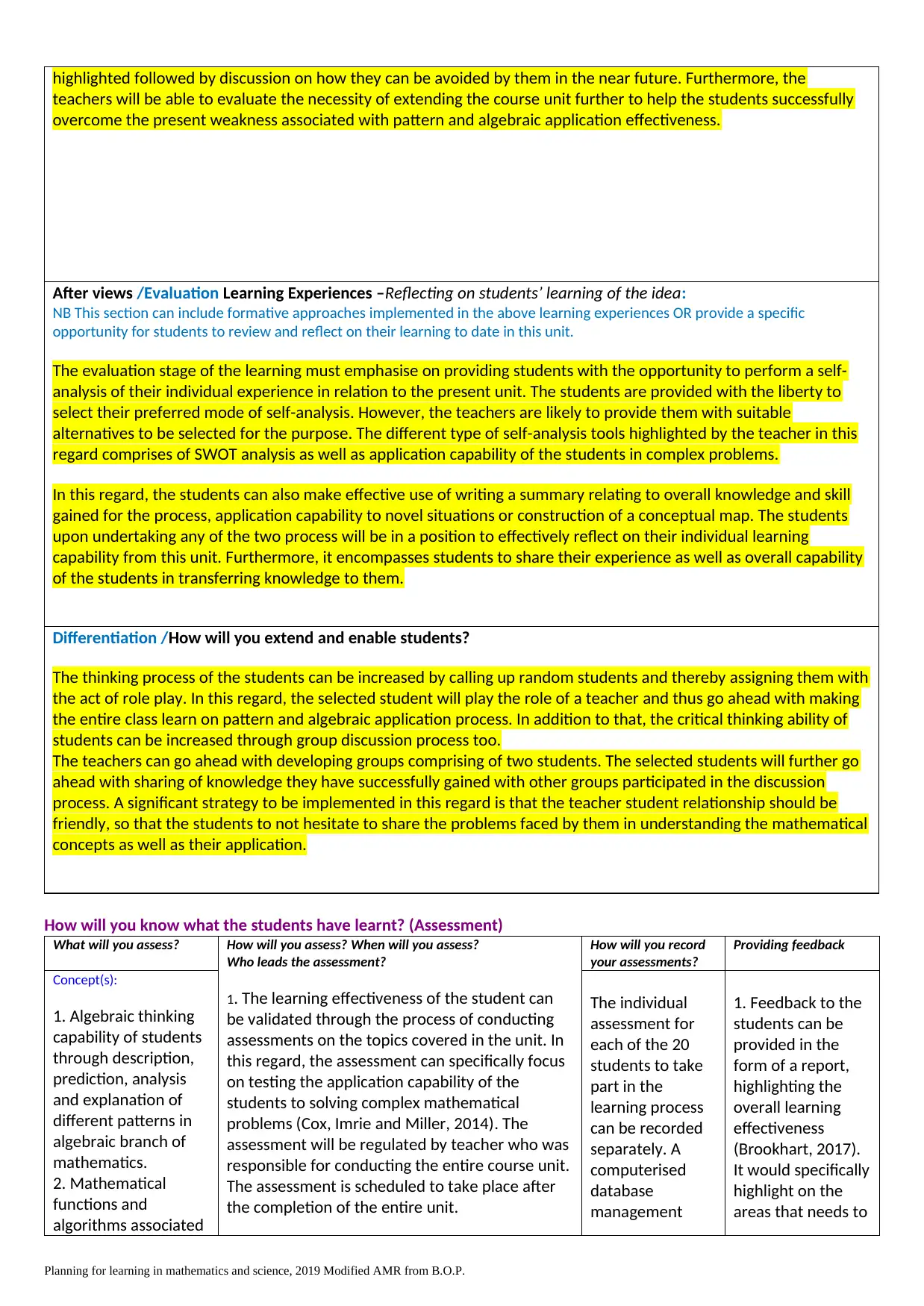
highlighted followed by discussion on how they can be avoided by them in the near future. Furthermore, the
teachers will be able to evaluate the necessity of extending the course unit further to help the students successfully
overcome the present weakness associated with pattern and algebraic application effectiveness.
After views /Evaluation Learning Experiences –Reflecting on students’ learning of the idea:
NB This section can include formative approaches implemented in the above learning experiences OR provide a specific
opportunity for students to review and reflect on their learning to date in this unit.
The evaluation stage of the learning must emphasise on providing students with the opportunity to perform a self-
analysis of their individual experience in relation to the present unit. The students are provided with the liberty to
select their preferred mode of self-analysis. However, the teachers are likely to provide them with suitable
alternatives to be selected for the purpose. The different type of self-analysis tools highlighted by the teacher in this
regard comprises of SWOT analysis as well as application capability of the students in complex problems.
In this regard, the students can also make effective use of writing a summary relating to overall knowledge and skill
gained for the process, application capability to novel situations or construction of a conceptual map. The students
upon undertaking any of the two process will be in a position to effectively reflect on their individual learning
capability from this unit. Furthermore, it encompasses students to share their experience as well as overall capability
of the students in transferring knowledge to them.
Differentiation /How will you extend and enable students?
The thinking process of the students can be increased by calling up random students and thereby assigning them with
the act of role play. In this regard, the selected student will play the role of a teacher and thus go ahead with making
the entire class learn on pattern and algebraic application process. In addition to that, the critical thinking ability of
students can be increased through group discussion process too.
The teachers can go ahead with developing groups comprising of two students. The selected students will further go
ahead with sharing of knowledge they have successfully gained with other groups participated in the discussion
process. A significant strategy to be implemented in this regard is that the teacher student relationship should be
friendly, so that the students to not hesitate to share the problems faced by them in understanding the mathematical
concepts as well as their application.
How will you know what the students have learnt? (Assessment)
What will you assess? How will you assess? When will you assess?
Who leads the assessment?
1. The learning effectiveness of the student can
be validated through the process of conducting
assessments on the topics covered in the unit. In
this regard, the assessment can specifically focus
on testing the application capability of the
students to solving complex mathematical
problems (Cox, Imrie and Miller, 2014). The
assessment will be regulated by teacher who was
responsible for conducting the entire course unit.
The assessment is scheduled to take place after
the completion of the entire unit.
How will you record
your assessments?
Providing feedback
Concept(s):
1. Algebraic thinking
capability of students
through description,
prediction, analysis
and explanation of
different patterns in
algebraic branch of
mathematics.
2. Mathematical
functions and
algorithms associated
The individual
assessment for
each of the 20
students to take
part in the
learning process
can be recorded
separately. A
computerised
database
management
1. Feedback to the
students can be
provided in the
form of a report,
highlighting the
overall learning
effectiveness
(Brookhart, 2017).
It would specifically
highlight on the
areas that needs to
Planning for learning in mathematics and science, 2019 Modified AMR from B.O.P.
teachers will be able to evaluate the necessity of extending the course unit further to help the students successfully
overcome the present weakness associated with pattern and algebraic application effectiveness.
After views /Evaluation Learning Experiences –Reflecting on students’ learning of the idea:
NB This section can include formative approaches implemented in the above learning experiences OR provide a specific
opportunity for students to review and reflect on their learning to date in this unit.
The evaluation stage of the learning must emphasise on providing students with the opportunity to perform a self-
analysis of their individual experience in relation to the present unit. The students are provided with the liberty to
select their preferred mode of self-analysis. However, the teachers are likely to provide them with suitable
alternatives to be selected for the purpose. The different type of self-analysis tools highlighted by the teacher in this
regard comprises of SWOT analysis as well as application capability of the students in complex problems.
In this regard, the students can also make effective use of writing a summary relating to overall knowledge and skill
gained for the process, application capability to novel situations or construction of a conceptual map. The students
upon undertaking any of the two process will be in a position to effectively reflect on their individual learning
capability from this unit. Furthermore, it encompasses students to share their experience as well as overall capability
of the students in transferring knowledge to them.
Differentiation /How will you extend and enable students?
The thinking process of the students can be increased by calling up random students and thereby assigning them with
the act of role play. In this regard, the selected student will play the role of a teacher and thus go ahead with making
the entire class learn on pattern and algebraic application process. In addition to that, the critical thinking ability of
students can be increased through group discussion process too.
The teachers can go ahead with developing groups comprising of two students. The selected students will further go
ahead with sharing of knowledge they have successfully gained with other groups participated in the discussion
process. A significant strategy to be implemented in this regard is that the teacher student relationship should be
friendly, so that the students to not hesitate to share the problems faced by them in understanding the mathematical
concepts as well as their application.
How will you know what the students have learnt? (Assessment)
What will you assess? How will you assess? When will you assess?
Who leads the assessment?
1. The learning effectiveness of the student can
be validated through the process of conducting
assessments on the topics covered in the unit. In
this regard, the assessment can specifically focus
on testing the application capability of the
students to solving complex mathematical
problems (Cox, Imrie and Miller, 2014). The
assessment will be regulated by teacher who was
responsible for conducting the entire course unit.
The assessment is scheduled to take place after
the completion of the entire unit.
How will you record
your assessments?
Providing feedback
Concept(s):
1. Algebraic thinking
capability of students
through description,
prediction, analysis
and explanation of
different patterns in
algebraic branch of
mathematics.
2. Mathematical
functions and
algorithms associated
The individual
assessment for
each of the 20
students to take
part in the
learning process
can be recorded
separately. A
computerised
database
management
1. Feedback to the
students can be
provided in the
form of a report,
highlighting the
overall learning
effectiveness
(Brookhart, 2017).
It would specifically
highlight on the
areas that needs to
Planning for learning in mathematics and science, 2019 Modified AMR from B.O.P.
Paraphrase This Document
Need a fresh take? Get an instant paraphrase of this document with our AI Paraphraser
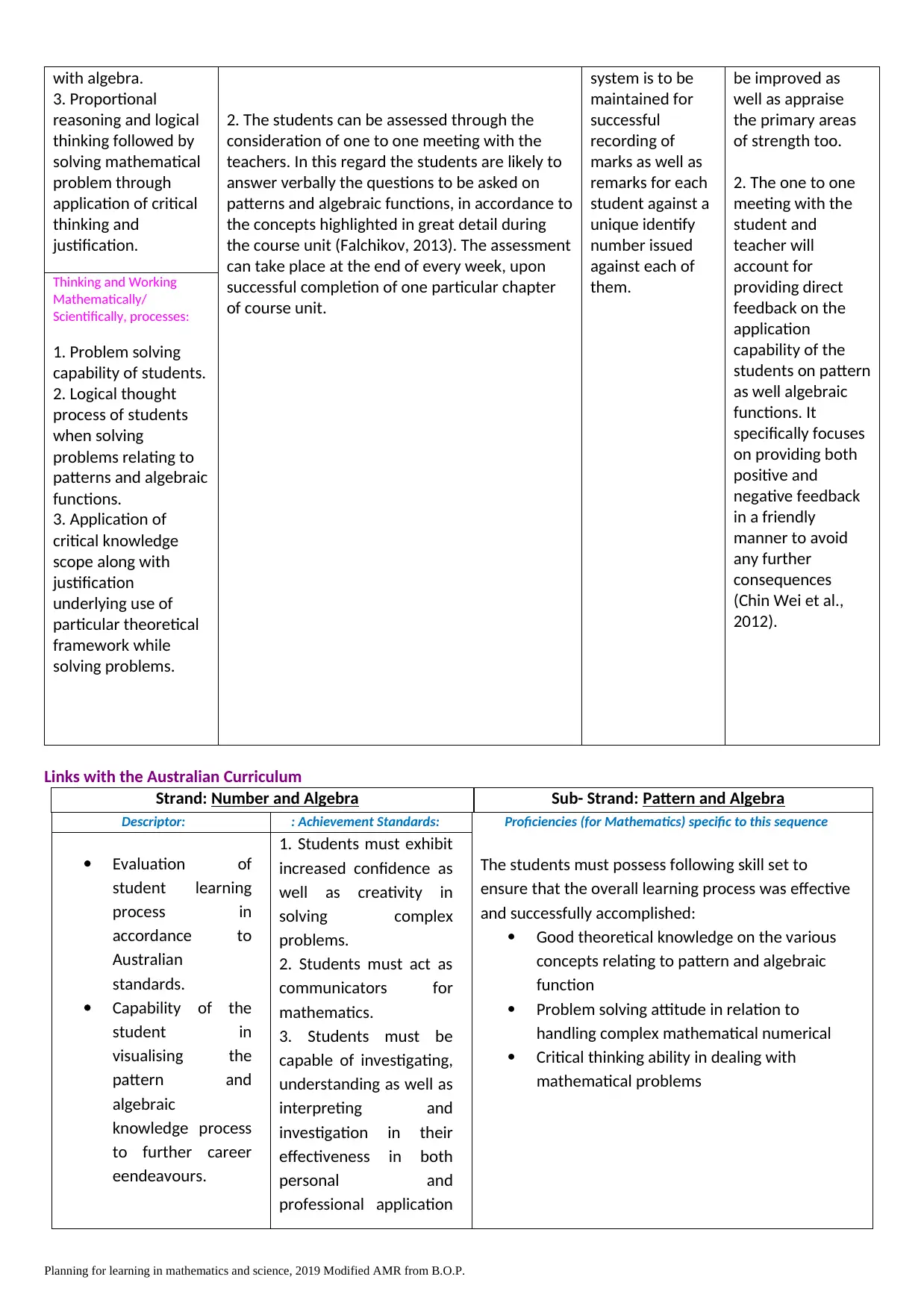
with algebra.
3. Proportional
reasoning and logical
thinking followed by
solving mathematical
problem through
application of critical
thinking and
justification.
2. The students can be assessed through the
consideration of one to one meeting with the
teachers. In this regard the students are likely to
answer verbally the questions to be asked on
patterns and algebraic functions, in accordance to
the concepts highlighted in great detail during
the course unit (Falchikov, 2013). The assessment
can take place at the end of every week, upon
successful completion of one particular chapter
of course unit.
system is to be
maintained for
successful
recording of
marks as well as
remarks for each
student against a
unique identify
number issued
against each of
them.
be improved as
well as appraise
the primary areas
of strength too.
2. The one to one
meeting with the
student and
teacher will
account for
providing direct
feedback on the
application
capability of the
students on pattern
as well algebraic
functions. It
specifically focuses
on providing both
positive and
negative feedback
in a friendly
manner to avoid
any further
consequences
(Chin Wei et al.,
2012).
Thinking and Working
Mathematically/
Scientifically, processes:
1. Problem solving
capability of students.
2. Logical thought
process of students
when solving
problems relating to
patterns and algebraic
functions.
3. Application of
critical knowledge
scope along with
justification
underlying use of
particular theoretical
framework while
solving problems.
Links with the Australian Curriculum
Strand: Number and Algebra Sub- Strand: Pattern and Algebra
Descriptor: : Achievement Standards: Proficiencies (for Mathematics) specific to this sequence
The students must possess following skill set to
ensure that the overall learning process was effective
and successfully accomplished:
Good theoretical knowledge on the various
concepts relating to pattern and algebraic
function
Problem solving attitude in relation to
handling complex mathematical numerical
Critical thinking ability in dealing with
mathematical problems
Evaluation of
student learning
process in
accordance to
Australian
standards.
Capability of the
student in
visualising the
pattern and
algebraic
knowledge process
to further career
eendeavours.
1. Students must exhibit
increased confidence as
well as creativity in
solving complex
problems.
2. Students must act as
communicators for
mathematics.
3. Students must be
capable of investigating,
understanding as well as
interpreting and
investigation in their
effectiveness in both
personal and
professional application
Planning for learning in mathematics and science, 2019 Modified AMR from B.O.P.
3. Proportional
reasoning and logical
thinking followed by
solving mathematical
problem through
application of critical
thinking and
justification.
2. The students can be assessed through the
consideration of one to one meeting with the
teachers. In this regard the students are likely to
answer verbally the questions to be asked on
patterns and algebraic functions, in accordance to
the concepts highlighted in great detail during
the course unit (Falchikov, 2013). The assessment
can take place at the end of every week, upon
successful completion of one particular chapter
of course unit.
system is to be
maintained for
successful
recording of
marks as well as
remarks for each
student against a
unique identify
number issued
against each of
them.
be improved as
well as appraise
the primary areas
of strength too.
2. The one to one
meeting with the
student and
teacher will
account for
providing direct
feedback on the
application
capability of the
students on pattern
as well algebraic
functions. It
specifically focuses
on providing both
positive and
negative feedback
in a friendly
manner to avoid
any further
consequences
(Chin Wei et al.,
2012).
Thinking and Working
Mathematically/
Scientifically, processes:
1. Problem solving
capability of students.
2. Logical thought
process of students
when solving
problems relating to
patterns and algebraic
functions.
3. Application of
critical knowledge
scope along with
justification
underlying use of
particular theoretical
framework while
solving problems.
Links with the Australian Curriculum
Strand: Number and Algebra Sub- Strand: Pattern and Algebra
Descriptor: : Achievement Standards: Proficiencies (for Mathematics) specific to this sequence
The students must possess following skill set to
ensure that the overall learning process was effective
and successfully accomplished:
Good theoretical knowledge on the various
concepts relating to pattern and algebraic
function
Problem solving attitude in relation to
handling complex mathematical numerical
Critical thinking ability in dealing with
mathematical problems
Evaluation of
student learning
process in
accordance to
Australian
standards.
Capability of the
student in
visualising the
pattern and
algebraic
knowledge process
to further career
eendeavours.
1. Students must exhibit
increased confidence as
well as creativity in
solving complex
problems.
2. Students must act as
communicators for
mathematics.
3. Students must be
capable of investigating,
understanding as well as
interpreting and
investigation in their
effectiveness in both
personal and
professional application
Planning for learning in mathematics and science, 2019 Modified AMR from B.O.P.

scope.
Links with the EYLF (for Reception/Foundation only)
Outcomes:
The final outcome of the overall learning process is that students were largely able to expand their mathematical
application process. However, furthermore, the effectiveness of the outcome elaborated in accordance to EYLF
principles is as follows:
1. The first principle is centred around a reciprocal and respectful relationship. In this regard, the teacher has taken the
primary role of developing good and cordial relationship with students through the learning process.
2. The second principles emphasises on developing partnership (Salamon, 2011). The teachers had also taken the
initiative to arrange parent teacher meeting, wherein the parents are educated on how they can help their children to
go ahead with the learning process.
3. The third principle centres around the overall expectation and equity development aspects. The teachers have
ensured providing support and help to every student irrespective of any biasness in terms of background. The teacher
was responsible for providing every individual with the opportunity to gain immense knowledge from the learning
process.
4. The fourth principle accounts for diversity. The teachers themselves as well as encourage others to value the
thought process as well perception of every individual from diverse cultural backgrounds.
5. The last principle ensured that the teacher has successfully delivered students to accomplish the practice associated
with continuous learning and periodic self-reflective analysis on the knowledge gained (Grieshaber, 2010).
Teacher Resources (What has informed your planning, background information, learning experiences, discussion of student understanding?)
The entire learning process has been planned in accordance to the various theoretical frameworks as well as concepts
existing within the secondary literature scope. Based on the theoretical concept, the entire course module has been
designed. Furthermore, the topics to be covered in the unit has been selected in accordance to the mathematical
standards followed by Australia for the purpose of enriching the knowledge scope of the students.
Student Resources (resources that you will need to gather/prepare to engage students with the learning)
The notable resources that has been considered for student learning on patterns and algebraic applications are books
available in the library both physical and online database. In addition to books, information about the concepts to be
taught were also searched in the internet.
Teacher Evaluation (Reflection: How effective have you been? This can be left blank until after implementation)
Please note that not every preservice teacher/ educator will have the opportunity to use this planner during placement.
To consider:
Which aspects were
most effective? The process encompassing enhancing the critical thinking and problem-solving attitude of
students, with special emphasis on pattern and algebraic functions.
Which aspects were
challenging? Why?
The process associated with gaining the attention of each of the 20 individual who
underwent the course unit was a little bit difficult and challenging.
Planning for learning in mathematics and science, 2019 Modified AMR from B.O.P.
Links with the EYLF (for Reception/Foundation only)
Outcomes:
The final outcome of the overall learning process is that students were largely able to expand their mathematical
application process. However, furthermore, the effectiveness of the outcome elaborated in accordance to EYLF
principles is as follows:
1. The first principle is centred around a reciprocal and respectful relationship. In this regard, the teacher has taken the
primary role of developing good and cordial relationship with students through the learning process.
2. The second principles emphasises on developing partnership (Salamon, 2011). The teachers had also taken the
initiative to arrange parent teacher meeting, wherein the parents are educated on how they can help their children to
go ahead with the learning process.
3. The third principle centres around the overall expectation and equity development aspects. The teachers have
ensured providing support and help to every student irrespective of any biasness in terms of background. The teacher
was responsible for providing every individual with the opportunity to gain immense knowledge from the learning
process.
4. The fourth principle accounts for diversity. The teachers themselves as well as encourage others to value the
thought process as well perception of every individual from diverse cultural backgrounds.
5. The last principle ensured that the teacher has successfully delivered students to accomplish the practice associated
with continuous learning and periodic self-reflective analysis on the knowledge gained (Grieshaber, 2010).
Teacher Resources (What has informed your planning, background information, learning experiences, discussion of student understanding?)
The entire learning process has been planned in accordance to the various theoretical frameworks as well as concepts
existing within the secondary literature scope. Based on the theoretical concept, the entire course module has been
designed. Furthermore, the topics to be covered in the unit has been selected in accordance to the mathematical
standards followed by Australia for the purpose of enriching the knowledge scope of the students.
Student Resources (resources that you will need to gather/prepare to engage students with the learning)
The notable resources that has been considered for student learning on patterns and algebraic applications are books
available in the library both physical and online database. In addition to books, information about the concepts to be
taught were also searched in the internet.
Teacher Evaluation (Reflection: How effective have you been? This can be left blank until after implementation)
Please note that not every preservice teacher/ educator will have the opportunity to use this planner during placement.
To consider:
Which aspects were
most effective? The process encompassing enhancing the critical thinking and problem-solving attitude of
students, with special emphasis on pattern and algebraic functions.
Which aspects were
challenging? Why?
The process associated with gaining the attention of each of the 20 individual who
underwent the course unit was a little bit difficult and challenging.
Planning for learning in mathematics and science, 2019 Modified AMR from B.O.P.
⊘ This is a preview!⊘
Do you want full access?
Subscribe today to unlock all pages.

Trusted by 1+ million students worldwide
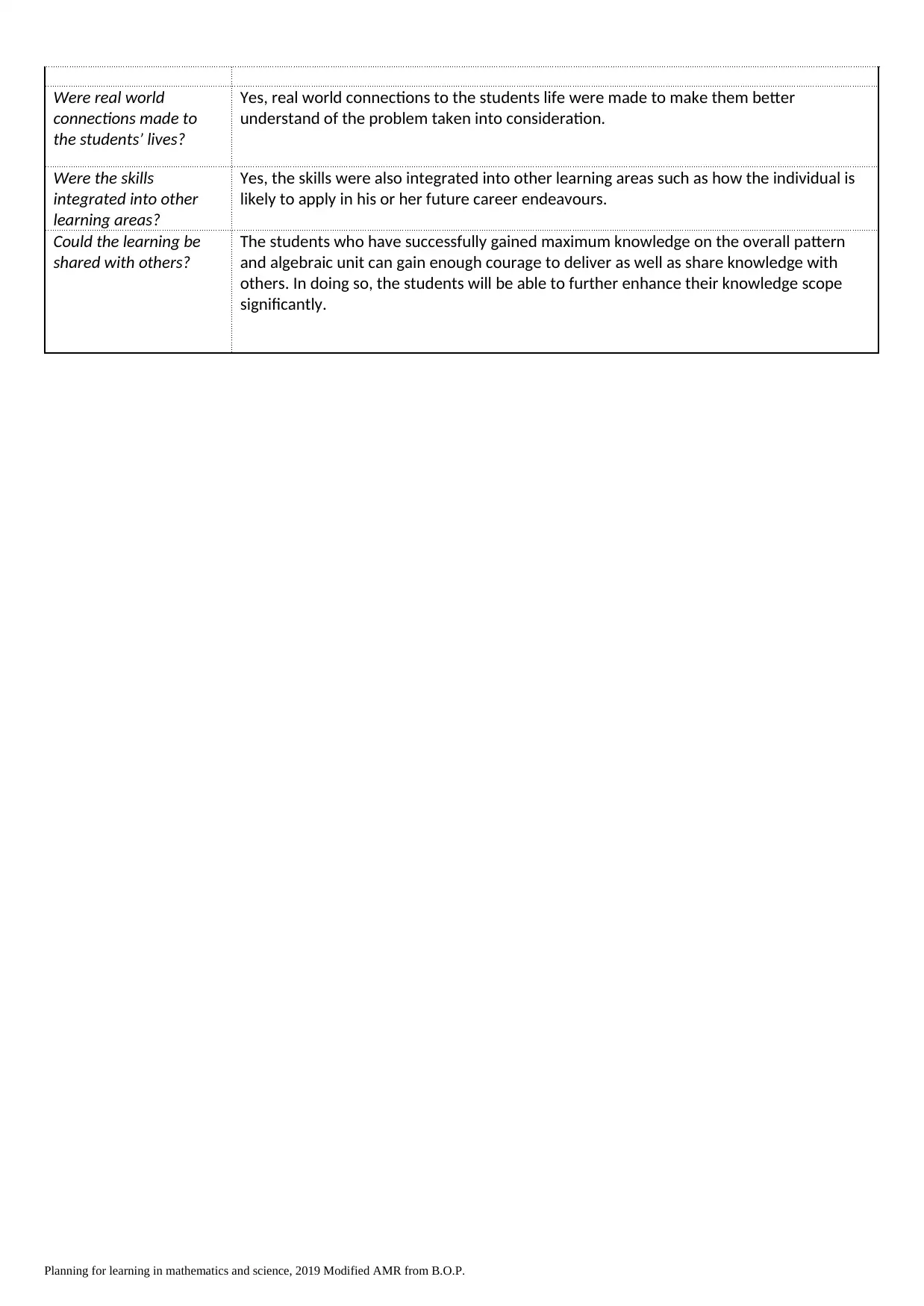
Were real world
connections made to
the students’ lives?
Yes, real world connections to the students life were made to make them better
understand of the problem taken into consideration.
Were the skills
integrated into other
learning areas?
Yes, the skills were also integrated into other learning areas such as how the individual is
likely to apply in his or her future career endeavours.
Could the learning be
shared with others?
The students who have successfully gained maximum knowledge on the overall pattern
and algebraic unit can gain enough courage to deliver as well as share knowledge with
others. In doing so, the students will be able to further enhance their knowledge scope
significantly.
Planning for learning in mathematics and science, 2019 Modified AMR from B.O.P.
connections made to
the students’ lives?
Yes, real world connections to the students life were made to make them better
understand of the problem taken into consideration.
Were the skills
integrated into other
learning areas?
Yes, the skills were also integrated into other learning areas such as how the individual is
likely to apply in his or her future career endeavours.
Could the learning be
shared with others?
The students who have successfully gained maximum knowledge on the overall pattern
and algebraic unit can gain enough courage to deliver as well as share knowledge with
others. In doing so, the students will be able to further enhance their knowledge scope
significantly.
Planning for learning in mathematics and science, 2019 Modified AMR from B.O.P.
Paraphrase This Document
Need a fresh take? Get an instant paraphrase of this document with our AI Paraphraser
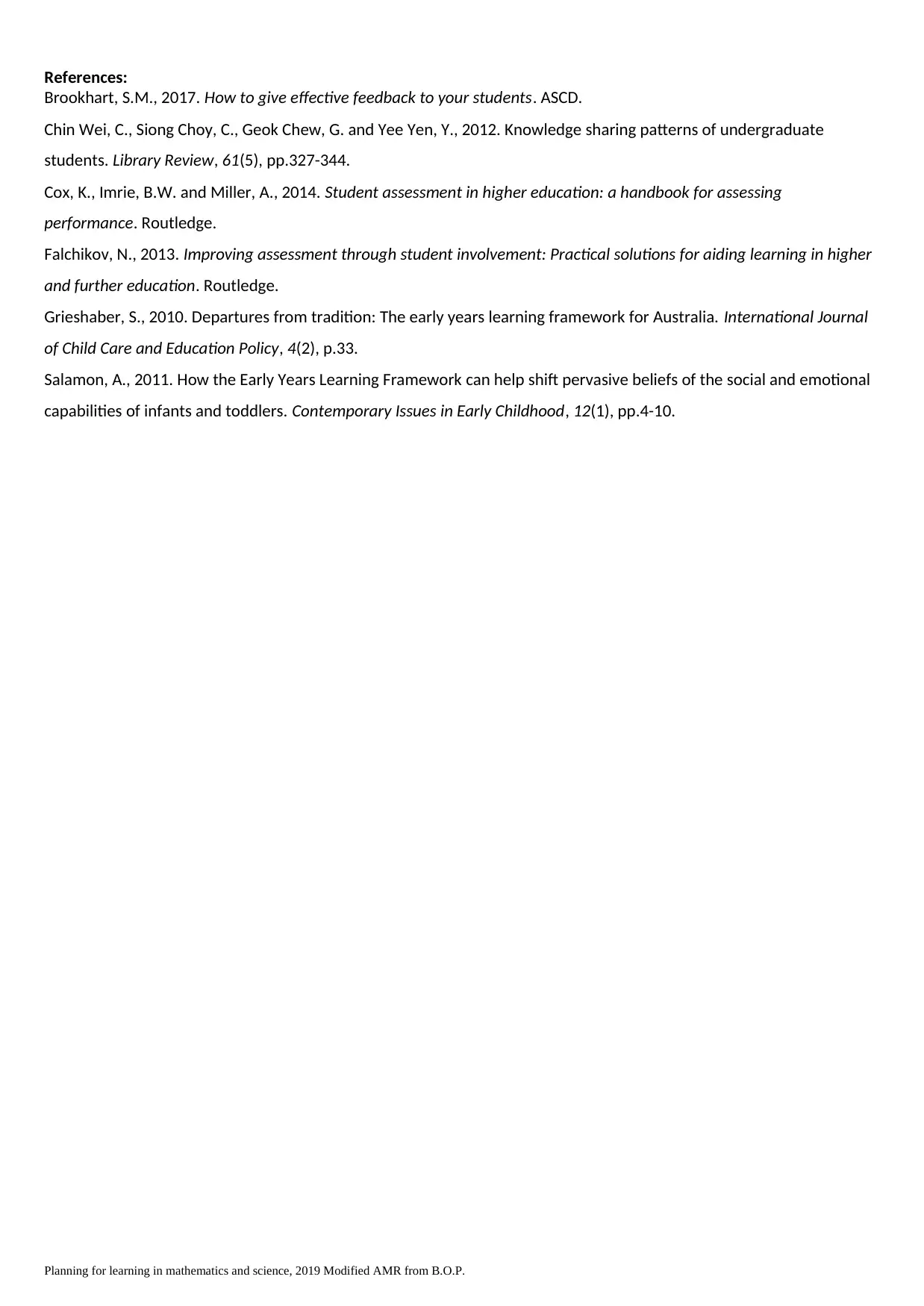
References:
Brookhart, S.M., 2017. How to give effective feedback to your students. ASCD.
Chin Wei, C., Siong Choy, C., Geok Chew, G. and Yee Yen, Y., 2012. Knowledge sharing patterns of undergraduate
students. Library Review, 61(5), pp.327-344.
Cox, K., Imrie, B.W. and Miller, A., 2014. Student assessment in higher education: a handbook for assessing
performance. Routledge.
Falchikov, N., 2013. Improving assessment through student involvement: Practical solutions for aiding learning in higher
and further education. Routledge.
Grieshaber, S., 2010. Departures from tradition: The early years learning framework for Australia. International Journal
of Child Care and Education Policy, 4(2), p.33.
Salamon, A., 2011. How the Early Years Learning Framework can help shift pervasive beliefs of the social and emotional
capabilities of infants and toddlers. Contemporary Issues in Early Childhood, 12(1), pp.4-10.
Planning for learning in mathematics and science, 2019 Modified AMR from B.O.P.
Brookhart, S.M., 2017. How to give effective feedback to your students. ASCD.
Chin Wei, C., Siong Choy, C., Geok Chew, G. and Yee Yen, Y., 2012. Knowledge sharing patterns of undergraduate
students. Library Review, 61(5), pp.327-344.
Cox, K., Imrie, B.W. and Miller, A., 2014. Student assessment in higher education: a handbook for assessing
performance. Routledge.
Falchikov, N., 2013. Improving assessment through student involvement: Practical solutions for aiding learning in higher
and further education. Routledge.
Grieshaber, S., 2010. Departures from tradition: The early years learning framework for Australia. International Journal
of Child Care and Education Policy, 4(2), p.33.
Salamon, A., 2011. How the Early Years Learning Framework can help shift pervasive beliefs of the social and emotional
capabilities of infants and toddlers. Contemporary Issues in Early Childhood, 12(1), pp.4-10.
Planning for learning in mathematics and science, 2019 Modified AMR from B.O.P.

Appendices
Please place each appendix in a numbered sequence beginning on a new page
Planning for learning in mathematics and science, 2019 Modified AMR from B.O.P.
Please place each appendix in a numbered sequence beginning on a new page
Planning for learning in mathematics and science, 2019 Modified AMR from B.O.P.
⊘ This is a preview!⊘
Do you want full access?
Subscribe today to unlock all pages.

Trusted by 1+ million students worldwide
1 out of 9
Related Documents
Your All-in-One AI-Powered Toolkit for Academic Success.
+13062052269
info@desklib.com
Available 24*7 on WhatsApp / Email
![[object Object]](/_next/static/media/star-bottom.7253800d.svg)
Unlock your academic potential
Copyright © 2020–2025 A2Z Services. All Rights Reserved. Developed and managed by ZUCOL.





